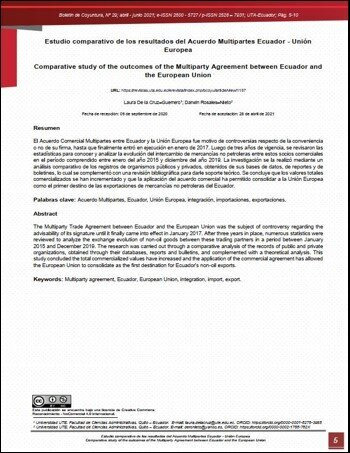Comparative study of the outcomes of the Multiparty Agreement between Ecuador and the European Union
Main Article Content
Abstract
The Multiparty Trade Agreement between Ecuador and the European Union was the subject of controversy regarding the advisability of its signature until it finally came into effect in January 2017. After three years in place, numerous statistics were reviewed to analyze the exchange evolution of non-oil goods between these trading partners in a period between January 2015 and December 2019. The research was carried out through a comparative analysis of the records of public and private organizations, obtained through their databases, reports and bulletins, and complemented with a theoretical analysis. This study concluded the total commercialized values have increased and the application of the commercial agreement has allowed the European Union to consolidate as the first destination for Ecuador's non-oil exports.
URL: https://revistas.uta.edu.ec/erevista/index.php/bcoyu/article/view/1157
Downloads
Article Details

This work is licensed under a Creative Commons Attribution-NonCommercial 4.0 International License.
![]()
The publications of the Boletín de Coyuntura are licensed under a Creative Commons Attribution-NonCommercial 4.0 International License (CC BY-NC 4.0). The Universidad Técnica de Ambato retains the copyright of the published works, and favors and allows the reuse of these, as long as: the authorship and original source of publication is cited, and they are not used for commercial or onerous purposes. The intellectual property of the published articles belongs to the authors.
References
Bayoumi, T., & Eichengreen, B. J. (1997). Is Regionalism Simply a Diversion? Evidence from the Evolution of the EC and EFTA. In Regionalism versus Multilateral Trade Arrangements, NBER-EASE (Vol. 6, pp. 141–168). Chicago: University of Chicago Press.
CAN. (2019). Comunidad Andina. September 15, 2019. http://www.comunidadandina.org/Seccion.aspx?id=189&tipo=QU&title=somos-comunidad-andina
Corbella, V. I. (2017). La integración comercial y productiva de ALADI y su cambio estructural. Economía UNAM, 14(41), 90–109. https://doi.org/10.1016/j.eunam.2017.06.005
De la Reza, G. (2015). Art . XXIV del gatt-omc?: la relación entre regionalismo y multilateralismo Art . XXIV of the gatt / wto?: the Relationship between Regionalism and Multilateralism. Revista Problemas Del Desarrollo, 181(46), 185–204.
European Commission. (2018). Cómo exportar a la Unión Europea. https://doi.org/10.2781/566645
Falcony y Oleas. (2012). El retorno de las carabelas?: Acuerdo Comercial Multipartes entre Ecuador y la Unión Europea. Quito. http://openbiblio.flacsoandes.edu.ec/libros/digital/52435.pdf
Herrera, L. (2017). Proceso De Integración De América Latina Y El Caribe Process of Integration of Latin America and the Caribbean Palabras Clave: América Latina * Caribe * Integración Regional * Sociología Política* Política De Desarrollo. Rev. Ciencias Sociales Universidad de Costa Rica, 158(IV), 167–183. http://www.cuba.cu/
Hill, C. (2015). Negocios Internacionales (Octava). México: MCGRAW-HILL.
Izquierdo, Novillo, & Mocha. (2019). Las bases del cambio de la matriz productiva en Ecuador. Universidad y Sociedad, 9(2), 313–318. http://scielo.sld.cu/scielo.php?script=sci_arttext&pid=S2218-36202019000400377
Latorre, J. (2017). El desarrollo de las negociaciones en el Acuerdo Comercial Multipartes de la UE con Ecuador Javier. FLACSO.
Lucio, J. (2019). Liderazgo geopolítico: el papel de los acuerdos comerciales. Comillas Journal of International Relations, (15), 52–77. https://doi.org/10.14422/cir.i15.y2019.005
Ministerio de Comercio Exterior. (2017). Memorias de las negociaciones del acuerdo multipartes entre Euador y la Unión Europea. Quito.
Ministerio de Comercio Exterior e Inversiones. (2018). Ecuador y la UE consideran positiva su relación comercial tras Acuerdo Multipartes. September 16, 2019. https://www.comercioexterior.gob.ec/ecuador-y-la-ue-consideran-positiva-su-relacion-comercial-tras-acuerdo-multipartes/
OMC. (2019). Organización Mundial de Comercio. September 14, 2019. https://www.wto.org/spanish/tratop_s/tariffs_s/tariffs_s.htm
OMC. (2020). Los principios del sistema de comercio. https://www.wto.org/spanish/thewto_s/whatis_s/tif_s/fact2_s.htm
Pérez, C. (1996). La mdernización industrial en América Latina y la Herencia, 46, 347–363.
Proecuador. (2018). Ficha Técnica de la Unión Europea. September 16, 2019, https://www.proecuador.gob.ec/ficha-tecnica-de-union-europea/
Pública, S. N. de C. (2020). Acuerdo comercial multipartes con la UE. https://portal.compraspublicas.gob.ec/sercop/acuerdo-comercial-multipartes-con-la-ue/
Rosales, D., & De La Cruz, L. (2019). Los primeros 18 meses del Acuerdo Multipartes Ecuador – Unión Europea. Podium, 35, 43–56. https://doi.org/10.31095/podium.2019.35.3
Sanahuja, J. (2013). La Unión Europea y el Regionalismo Latinoamericano: Un balance. Investigación & Desarrollo, 21(1).
Saura, J. (2013). Implicaciones de derechos humanos en el tratado de libre comercio entre Colombia y la Unión Europea. InDret. https://www.raco.cat/index.php/InDret/article/viewFile/270131/357687
Unión Europea. (2020). Ecuador y la Unión Europea. Retrieved from https://eeas.europa.eu/delegations/ecuador/1146/ecuador-y-la-unión-europea_es
Vargas, J. (2007). Las reglas cambiantes de la competitividad global en el nuevo milenio:Las competencias en el nuevo paradigma de la globalización. In Red Internacional de Investigadores en Competitividad Memoria del I Congreso (pp. 0–21). Red Internacional de Investigadores en Competitividad. https://www.riico.net/index.php/riico/article/view/1050/411
Villagómez, M. (2017). Acuerdo comercial multipartes Ecuador - Unión Europea. AFESE, 56, 11–51.
Zúñiga; Espinoza; Campos; Tapia; Muñoz. (2016). Una mirada a la globalización: pymes ecuatorianas. Observatorio de La Economía Latinoamericana, Ecuador. http://www.eumed.net/cursecon/ecolat/ec/2016/pymes.html


